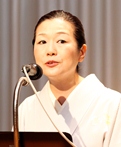Business Administration of Hanamachi in Kyoto --- Its Secrets over 350 Years
June 20, 2012
Ms. Kumiko Nishio
Associate Professor, Department for the Study of Contemporary Society, Kyoko Women��s University
 ��Hanamachi (geisha district, literally meaning flower streets) has a long history over 350 years. My speech will be on a business analysis of this industry, while revealing its skills of entertainment and hospitality.
��Hanamachi (geisha district, literally meaning flower streets) has a long history over 350 years. My speech will be on a business analysis of this industry, while revealing its skills of entertainment and hospitality.
��Today, there are about 200 geiko (Kyoto dialect for geisha, mostly over 20 years old) and 90 maiko (geisha in training, mostly younger than 20) in hanamachi. Around 150 ochaya (literally meaning tea house, but actually a strictly-exclusive guest house) are engaged in their management and the arrangements for ozashiki banquets. Ochaya looks like an ordinary townhouse with no marked signs, no price lists nor menus, a unique feature in Kyoto for a high-end entertainment establishment.
��The number of maiko and geiko remained stable, even amidst economic stagnation triggered by the collapse of the bubble economy and the Lehman Shock, which proves the soundness of its business administration.
��In older times, daughters of ochaya or okiya (geisha house or agent) became maiko. As increasing number of girls chose to pursue higher education, the five hanamachi in Kyoto started to receive fewer applicants. By 1975, the number of applicants dropped below 30.
��In Kyoto, it is believed that ��tradition is built on continuous innovations.�� Hanamachi took immediate measures to loosen regulations and accept candidates with some connections from all over Japan. For the past 10 years, candidates started to apply electronically via websites. Today, there are internship programs for interested junior high school girls, providing chances to stay at okiya to see if they really want to become professional maiko. Once they decide, candidates start the shikomi training (probationary period) at okiya��with the approval of their parents. They choose to become maiko with high hopes and aspirations.
��Okami-san (mistress) of ochaya takes maiko around the world, upon request from their clients. Maiko attended the Shanghai Expo or ceremonies at their clients�� overseas offices.
��Okiya serve as agents and train geiko and maiko. Ochaya arrange banquets that best satisfy their customers�� tastes by allocating suitable geiko and maiko and sending them to locations, sometimes outside the ochaya.
Maiko wears extremely expensive costumes, and its pattern changes about three times during the five-year-maiko period. For example, maiko wears red silk neckbands with gorgeous and colorful embroideries. As they get older, the embroideries become less colorful and whiter. Their hairstyles also differ, depending on the years of service. Geiko and maiko work in a team, and the one with the longest experience will be the team leader. Combination of team members differs for each ozashiki banquet. The seating position and function at the banquet also depend on their experience, so by just looking at them, you can tell how long they have been geiko or maiko.
��Okiya in Kyoto serves as specialized company for HR. Those would-be maiko live at okiya and get trainings from okasan (okami-san) during the probationary period of about one year. Extensive trainings on Kyoto dialect, deportment at ozashiki and how to wear the kimono are given, just like mothers do to their own daughters. Trainings on special skills of classical Japanese dance, tea ceremony and shamisen (3-stringed Japanese guitar) are given at schools at Hanamachi.
��Maiko makes a debut with the approval from a dancing mistress. Onesan (elder sister) will be appointed for each maiko as a mentor and she takes full responsibility for her younger sister. If anything goes wrong at the ozashiki, all the information and complaints are shared with onesan, and maiko gets further training and advice not to repeat the same mistake. This pseudo sisterhood relationship is not necessarily built between maiko and onesan from the same okiya, but sometimes geiko from a rival okiya becomes onesan.
��Let me touch upon ��zamochi,�� the special skills of entertaining the guests. Three elements constitute ��zamochi��: traditional cultural skills, elegant deportment, and a quick response to various needs of the guests. Ideal ��zamochi�� requires grasping what the guests expect and providing the best service through demonstrating one��s own skills.
��Ochaya are like member-exclusive clubs and have the policy of ��refusing service to customers without an introduction.�� Ochaya compiles information on guests to provide meticulous treats that meets their needs. Ochaya sometimes teach rules of hanamachi to new customers so that high-quality services are maintained.
��Business in hanamachi is based on competition and collaboration. Having rivals guarantees good quality. Yet, collaboration with rivals will promote greater demand from customers.
��Hanadai (literally means ��flower fee��, but actually a fee for geiko and maiko) are settled by the union. Maiko and geiko work under the principle of equal pay for equal jobs. The industry consists of professionals for entertainment and hospitality, and those who fail to meet customers�� expectations are forced to leave.
��In September 2007, I published ��Business Administration of Hanamachi in Kyoto.�� In Chapter 8, you will find a summary of business structure that guarantees the super long-term competitive advantage.
��Let me close my speech by presenting you two words as a souvenir, which underlie the business at hanamachi in Kyoto. One is ��kibarashite-moraimasu��, which means to gather correct information and assess the circumstances to make due response. The other is ��aikawari-masezu��, which means to continue good relationships by respecting others. We must keep working to gain increased customer satisfaction. I believe these two words are essential for good personal and business relationships in any industries.